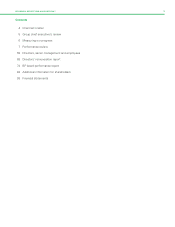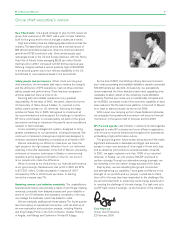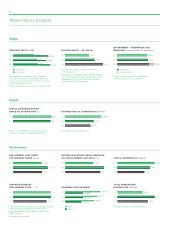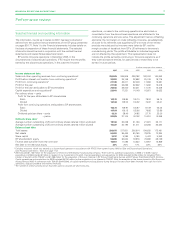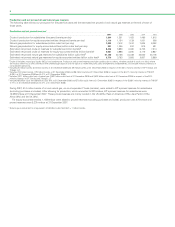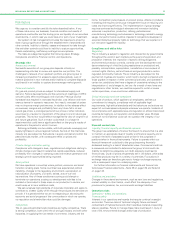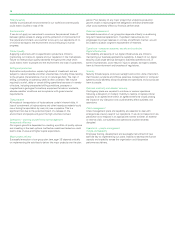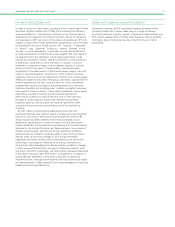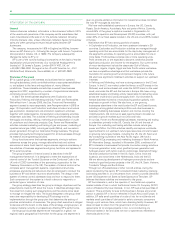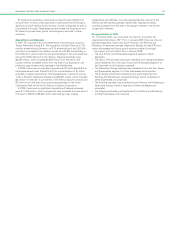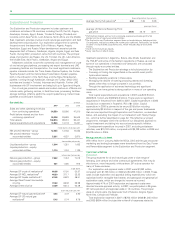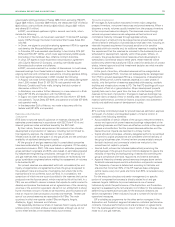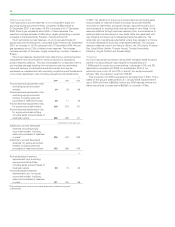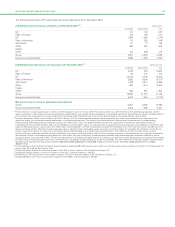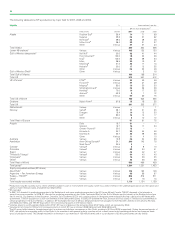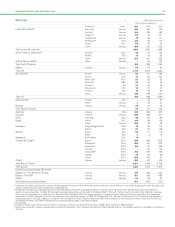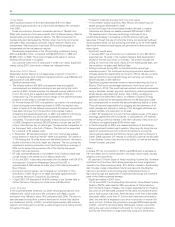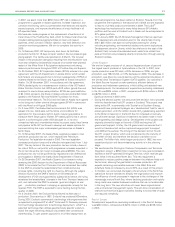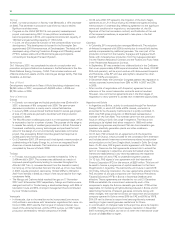BP 2007 Annual Report Download - page 14
Download and view the complete annual report
Please find page 14 of the 2007 BP annual report below. You can navigate through the pages in the report by either clicking on the pages listed below, or by using the keyword search tool below to find specific information within the annual report.
Information on the company
General
Unless otherwise indicated, information in this document reflects 100%
of the assets and operations of the company and its subsidiaries that
were consolidated at the date or for the periods indicated, including
minority interests. Also, unless otherwise indicated, figures for business
sales and other operating revenues include sales between BP
businesses.
The company, incorporated in 1909 in England and Wales, became
known as BP Amoco p.l.c. following the merger with Amoco Corporation
(incorporated in Indiana, US, in 1889). The company subsequently
changed its name to BP p.l.c.
BP is one of the world’s leading oil companies on the basis of market
capitalization and proved reserves. Our worldwide headquarters is
located at 1 St James’s Square, London SW1Y 4PD, UK, tel
+44 (0)20 7496 4000. Our agent in the US is BP America Inc., 4101
Winfield Road, Warrenville, Illinois 60555, tel +1 630 821 2222.
Overview of the group
BP is a global group, with interests and activities held or operated
through subsidiaries, jointly controlled entities or associates established
in, and subject to the laws and regulations of, many different
jurisdictions. These interests and activities covered three business
segments in 2007, supported by a number of organizational elements
comprising group functions and regions.
In 2007, the three business segments were Exploration and
Production, Refining and Marketing and Gas, Power and Renewables.
With effect from 1 January 2008, the Gas, Power and Renewables
segment ceased to report separately (see Resegmentation in 2008 on
page 13). Exploration and Production’s activities include oil and natural
gas exploration, development and production (upstream activities),
together with related pipeline, transportation and processing activities
(midstream activities). The activities of Refining and Marketing include
the supply and trading, refining, marketing and transportation of crude
oil, petroleum and chemicals products. Gas, Power and Renewables
activities included marketing and trading of gas and power, marketing of
liquefied natural gas (LNG), natural gas liquids (NGLs), and low-carbon
power generation through our Alternative Energy business. The group
provides high-quality technological support for all its businesses through
its research and engineering activities.
Group functions serve the business segments, aiming to achieve
coherence across the group, manage risks effectively and achieve
economies of scale. Each head of region ensures regional consistency of
the activities of business segments and group functions and represents
BP to external parties.
The group’s system of internal control is described in the BP
management framework. It is designed to meet the expectations of
internal control of the Turnbull Guidance on the Combined Code in the
UK and of COSO (committee of the sponsoring organization for the
Treadway Commission in the US). The system of internal control is the
complete set of management systems, organizational structures,
processes, standards and behaviours that are employed to conduct the
business of BP and deliver returns to shareholders. The design of the
system of internal control addresses risks and how to respond to them.
Each component of the system is in itself a device to respond to a
particular type or collection of risks.
The group strategy describes the group’s strategic objectives and the
presumptions made by BP about the future. It describes strategic risks
that arise from making such presumptions and the actions to be taken
to manage or mitigate the risks. The board delegates to the group chief
executive responsibility for developing BP’s strategy and its
implementation through the group plan that determine the setting of
priorities and allocation of resources. The group chief executive is obliged
to discuss with the board, on the basis of the strategy and group plan, all
material matters currently or prospectively affecting BP’s performance.
As the group’s business segments are managed on a global, not
regional, basis, geographical information for the group and segments is
given to provide additional information for investors but does not reflect
the way BP manages its activities.
We have well-established operations in Europe, the US, Canada,
Russia, South America, Australasia, Asia and parts of Africa. Currently,
around 65% of the group’s capital is invested in Organisation for
Economic Co-operation and Development (OECD) countries, with just
under 40% of our fixed assets located in the US and around 25% located
in Europe.
We believe that BP has a strong portfolio of assets:
– In Exploration and Production, we have upstream interests in 29
countries. Exploration and Production activities are managed through
operating units that are accountable for the day-to-day management of
the segment’s activities. An operating unit is accountable for one or
more fields. Profit centres comprise one or more operating units.
Profit centres are, or are expected to become, areas that provide
significant production and income for the segment. Our current areas
of major development include the deepwater Gulf of Mexico,
Azerbaijan, Algeria, Angola, Egypt and Asia Pacific where we believe
we have competitive advantage and that we believe provide the
foundation for volume growth and improved margins in the future.
We also have significant midstream activities to support our upstream
interests.
– In Refining and Marketing, we have a strong presence in the US and
Europe. In the US, we market under the Amoco and BP brands in the
Midwest, east and southeast and under the ARCO brand on the west
coast, and under the BP and Aral brands in Europe. We have a long-
established supply and trading activity responsible for delivering value
across the crude and oil products supply chain. Our Aromatics &
Acetyls business maintains a manufacturing position globally, with
emphasis on growth in Asia. We also have, or are growing,
businesses elsewhere in the world under the BP and Castrol brands,
including a strong global lubricants portfolio and other business-to-
business marketing businesses (aviation and marine) covering the
mobility sectors. We continue to seek opportunities to broaden our
activities in growth markets such as China and India.
– In our Gas, Power and Renewables businesses, marketing and trading
is undertaken primarily in the US, Canada, the UK and the rest of
Europe. Our marketing and trading activities include natural gas,
power and NGLs. Our LNG activities identify and capture worldwide
opportunities for our upstream natural gas resources and are focused
on growing natural gas markets, including the US, the UK, Spain and
key consuming countries of the Asia Pacific region. We have a
significant NGLs processing and marketing business in North America.
BP Alternative Energy, launched in November 2005, combines all of
BP’s interests in businesses that provide low-carbon energy solutions
for power generation: solar, wind, gas-fired power generation and
hydrogen power with carbon capture and storage. Alternative Energy
has solar production facilities in the US, Spain, China, India and
Australia; and wind farms in the Netherlands, India and the US.
We are advancing development of hydrogen power plants and are
involved in gas-fired power projects in the US, the UK, Spain, Vietnam,
Trinidad & Tobago and South Korea.
Through non-US subsidiaries or other non-US entities, during the
period covered by this report, BP conducted limited marketing, licensing
and trading activities in, or with persons from, certain countries identified
by the US Department of State as State Sponsors of Terrorism. BP
believes that these activities are immaterial to the group.
BP has interests in, and is the operator of, two fields and a pipeline
located outside of Iran in which the National Iranian Oil Company (NIOC)
and an affiliated entity have interests. In Iran, BP buys small quantities of
crude oil. This is primarily for sale to third parties in Europe and a small
portion is used by BP in its own refineries in South Africa and Europe. In
addition, BP sells small quantities of crude oil into Iran and blends and
markets small quantities of lubricants for sale to domestic consumers
through a joint venture there, which has a blending facility. However, BP
does not seek to obtain from the government of Iran licences or
agreements for oil and gas projects in Iran, is not conducting any
technical studies in Iran and does not own or operate any refineries or
chemicals plants in Iran.
12



